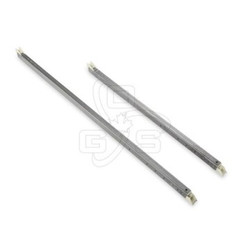How to clean or repair double hung windows that do not tilt
Tired of dirty double hung windows but not sure how to remove them and get to sparkling them up? Or perhaps your windows are not staying up as they should, falling down, or just not moving much at all. In this guide we’ll cover both how to remove your sashes (moveable windows) from your double hung window frame and how to repair or replace the block and tackle balances that facilitate the movement of your sash.
Here’s a few quick links to help you skip the fluff:
- How to remove and clean non-tilting double hung windows
- How to repair non-tilting double hung windows
- Video on replacing a block and tackle assembly
A very brief overview of double hung windows and some of the terminology used in the guide:
Millions of non-tilting double hung windows continue to be installed worldwide and utilize a counterbalancing spring assembly that many in the glazing industry may refer to as sash balances, channel balances, or more specifically block and tackle balances.
Block and Tackle Balances
Standard commercial and residential applications utilize two block and tackle balances per sash. These block and tackle balances are commonly affixed to the jamb of your windows (the sides of your window frame) and facilitate the opening and closing of your windows via a spring and string tension assembly.
Block and Tackle Feet
The bottom of each block and tackle balance has what we refer to as the foot of the balance which hugs the bottom of the sash when the respective sash is properly seated in the frame and riding up and down with the balances.
Sash Cams
Commonly affixed to the top corners of each sash are plastic sash cams. Sash cams help prevent the block and tackle balances from moving beyond the top of the sash.
Take-out clips
Commonly constructed out of aluminum, take-out clips are designed to facilitate the easy removal of block and tackle balances from their respective jambs. You will find these take-out clips towards the top of each jamb that a block and tackle balance rides in.
How to remove and clean non-tilting double hung windows
Items you will need:
- A small flat head screwdriver
Items we recommend:
- A pair of gloves to protect your hands
Step 1:
Lower the interior lower sash (window) to the closed position.
Step 2:
Use the small flat head screwdriver to “pop” the sash take-out clips out on both sides of the sash from the bottom towards the center of the window. The sash take-out clips are typically located about 4 inches down from the top of the window frame in the channel the sash rides in.
Step 3:
Push the interior sash up past the protruding sash-takeout clips to about two inches away from the top of the window frame. The take-out clips are meant to “catch” the sash balances and prevent it from moving further up the channel as the sash itself extends upwards beyond them.
Step 4:
With the sash approximately 2 inches away from the top of the window frame, position one hand along the top of the sash and another hand along the bottom. Push or pull, depending upon which movement you are more comfortable with – the sash towards one side of the window frame.
Step 5:
With the sash pushed in towards one side of the rail, hinge the opposite side of the sash inward towards the interior of the house.
Step 6:
Your sash should now be free from the window frame and the cleaning or repairs can begin! Reverse the steps to return your sash to your double hung window frame and resume operation as usual albeit with clean windows!
NOTE: The same steps apply when removing the exterior sash.
How to repair non-tilting double hung windows by replacing block and tackle balances
Items you will need:
- A small flat head screwdriver
Items you may need:
- A screwdriver matching the configuration of the screws mounting your sash cams to the top of the sash.
Items we recommend:
- A can of dry lubricant silicone spray. Not WD-40!
- A pair of gloves to protect your hands.
Note: The following steps refer to the interior lower sash but can be applied to the upper exterior sash as well.
Step 1:
Lower the interior lower sash (window) to the closed position.
Step 2:
Use the small flat head screwdriver to “pop” the sash take-out clips out on both sides of the sash from the bottom towards the center of the window. The sash take-out clips are typically located about 4 inches down from the top of the window frame in the channel the sash rides in.
Step 3:
Push the interior sash up past the protruding sash-takeout clips to about two inches away from the top of the window frame. The take-out clips are meant to “catch” the sash balances and prevent it from moving further up the channel as the sash itself extends upwards beyond them.
Step 4:
With the sash approximately 2 inches away from the top of the window frame, position one hand along the top of the sash and another hand along the bottom. Push or pull, depending upon which movement you are more comfortable with – the sash towards one side of the window frame.
Step 5:
With the sash pushed in towards one side of the rail, hinge the opposite side of the sash inward towards the interior of the house. The sash should now be free of the window frame.
Step 6:
Inspect the sash cams on either side of the sash for signs of damage or fatigue. If broken, the sash cam will have to be removed by unscrewing the mounting screw holding it in place. Take note of the dimensions of this sash cam as a replacement will need to be ordered.
Step 7:
With the sash window free of the window frame, grab the top of the sash balance located in the jamb and push downward on the balance assembly away from the sash-clip. With the balance one inch or more below the sash-clip, pull the top of the sash balance out towards the center of the window frame so that it forms a 60° angle with the horizontal surface of the bottom of the window frame and pull up to remove the sash balance from the window frame sash channel.
Step 8.
Look for and identify the series of numbers printed on the aluminum body of the sash balance located by the foot of the balance. These numbers correspond to the length and strength of the sash balance.
Step 9:
Browse our selection of block and tackle balances for your replacement today.
Step 10:
With your replacement parts in hand, perform the above steps in reverse to have your double hung windows working like new again!
DIY Window Repair: How to fix the (sash) Channel Balance for Single Fix Window
Ontario Glazing Supplies is currently working on a new video, but in the mean time you might find the following video helpful:
Need help? Contact us for more information on finding the right part for your DIY window repair project.


 Canadian Dollars
Canadian Dollars
 US Dollar
US Dollar
 Mexican Peso
Mexican Peso
 Euro
Euro
 British Pound
British Pound
 Australian Dollar
Australian Dollar
